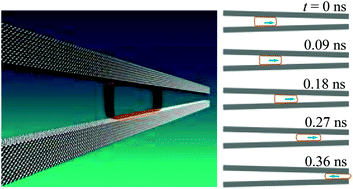Nanoscale directional motion by angustotaxis†
Abstract
Directing motion of a nanoscale object on solid surfaces, in particular in an intrinsic way, is crucial for many aspects of nanotechnology applications. Here we report a novel intrinsic mechanism for nanoscale directional motion, termed angustotaxis, where a wide single walled carbon nanotube in a tapered channel drives itself toward the narrower end of the channel. The underlying physics of angustotaxis is attributed to the lower system potential when the nanotube is at a narrower region of the channel due to the increased contact area between the nanotube and the channel. Angustotaxis could lead to promising routes not only for nanoscale energy conversion from van der Waals potential to mechanical work, but also for mass transport like surface cleaning.



 Please wait while we load your content...
Please wait while we load your content...